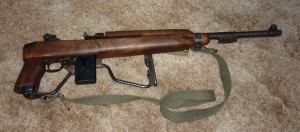
Modern armies have faced a small dilemma: what should they use to arm personnel who are not fighting on the front line? A full-size rifle is too big to let them do their (non-combat) jobs, and a pistol is too weak and too inaccurate to be effective as a weapon in battle.
The answer to this dilemma used to be to chop down the barrel of the primary service rifle, to make a “cavalry” or “jungle” version. But that made the rifle only a little shorter and a little lighter (and probably a lot louder and brighter).
To meet this need, United States developed the lightweight M1 carbine, and a new intermediate cartridge (with greater power than pistol rounds but less power than a full-size rifle). The M1 (and folding-stock M1A1) would arm Airborne troops and many support personnel from 1942 onward. There would also be select-fire M2 and infrared-scoped M3 versions. (Some sources attribute 30% of Japanese rifle/carbine casualties in the Okinawa campaign to the M3; if true, it would seem that we owned the night even then.)
The M1 and its variants served the United States and its allies through WW2 and Korea, and in limited numbers in Vietnam. It had more power than the Thompson/M3 submachineguns in use at the time, while being lighter and more compact than a rifle.
In 1963, a man named Melvin Johnson created a necked-down .22 version of the M1 carbine, and called it the 5.7 Spitfire. It fired a smaller, lighter bullet traveling at a higher velocity with a flatter trajectory. While interesting, the idea generated a little buzz and not much more. Wildcat cartridges are not uncommon, after all.
Technology and ballistics advanced to the point that weapons designers have conceived and executed some fascinating ideas. And a new term was born: Personal Defense Weapon (PDW).
According to WikiPedia . . .
A personal defense weapon (often abbreviated PDW) is a compact semi-automatic or fully-automatic firearm similar in most respects to a submachine gun, but firing an (often proprietary) armor-piercing round, giving a PDW better range, accuracy and armor-penetrating capability than submachine guns, which fire pistol-caliber cartridges. The class of weapon as it exists today evolved as a hybrid between a submachine gun and a carbine, retaining the compact size and ammunition capacity of the former while adding the ammunition power, accuracy and penetration of the latter.
Just as an “assault rifle” is a smaller longarm than a rifle, firing a less-powerful cartridge in bursts or full-auto, a PDW seems to be defined as something more than a pistol/machinepistol/submachinegun and less than a rifle or assault rifle. Often, the need to penetrate armor is central to a PDW’s design.
The most famous PDW is the FN P90, shown here with its companion FiveseveN pistol:
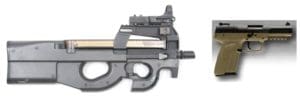
Many innovative features debuted on the P90: downward ejection, a 50-round magazine that does not protrude from the gun, and unique ergonomics that permit a solid 2-handed grip while keeping the gun very compact. The P90 is currently in service with many American law-enforcement agencies, and dozens of foreign countries.
Some people have (rightly) criticized the P90’s 5.7x28mm cartridge as being in the same class as the .22 magnum. In terms of sheer muzzle energy, the 5.7x28mm has slightly more power. But it also has the advantage of centerfire ignition (more reliable ignition than rimfire, more reliable in feeding since it is rimless, and more resistant to impact) and better options in bullets (true armor-piercing SS190 rounds, for example).
The P90’s short on “stopping power.” However, the gun fulfills its original intent: allow many smaller bullets to penetrate armor and cause wounds (instead of a single larger bullet). Low recoil makes that possible.
The other well-known PDW is Heckler&Koch’s MP7 (seen here with its companion UCP/P46 pistol, since cancelled):

The buttstock of the MP7 pulls out straight from the back of the gun. The 4.6x30mm round that HK chose for these guns is roughly in the same class as the 5.7x28mm, and shares the same focus on armor-piercing performance. Britain uses the MP7 to arm its Ministry of Defence Police. Norway is replacing all HK MP5 submachineguns currently used by its military with the MP7.
Knight’s Armament has a PDW of their own, called the PDW, complete with a proprietary 6x35mm cartridge:
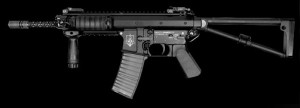
There is no recoil mechanism in that stock; it folds forward to the right side of the PDW. To their credit, the 6x35mm cartridge that Knights developed offers more than double the muzzle energy of the 5.7x28mm, while claiming 50% of the recoil of an M4 carbine.
Sweden has worked on a PDW and cartridge of their own, the Saab Bofors CBJ-MS:
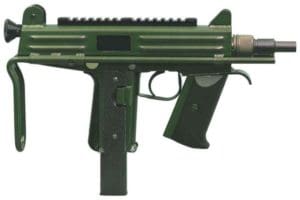
Saab Bofors took a slightly different path with their proprietary 6.5x25mm cartridge. They use a 4mm tungsten penetrator inside a 6.5mm sabot to achieve very high velocity.
China has developed their version of a PDW in the QCQ-05 submachinegun:
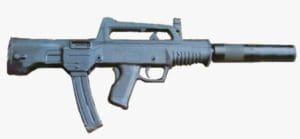
They developed two versions of their 5.7x21mm cartridge: a full-power version for use in the QCQ-05, and a subsonic version for use in the silenced QCW-05 submachinegun and QSZ-92 silenced pistol.
A Belgian firm is developing a pistol-based PDW called the VBR:
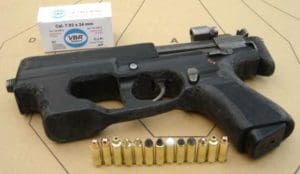
The VBR’s in the prototype stage; it looks like something I might have made in shop class in junior high. There are several versions extant. The (once again) proprietary 7.92x24mm ammunition uses a tapered (rather than bottlenecked) case and is made in two varieties: a short projectile to let the cartridge chamber in 9mm platforms and a longer projectile that will fit into .45acp platforms.
Russia is following closer to the VBR path with their PP-2000:
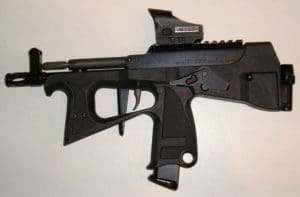
The PP-2000 uses special 7n31 ammunition, which combines the standard 9mm cartridge case with lightweight projectiles designed to pierce armor, and loads them to higher-than-normally-accepted pressures.
That’s a good cross-section of the PDW offerings to date. While many are very cool looking, only the P90 has been used in real-world operations (that we know of).
So, how do the various PDW cartridges stack up? Let’s take a look. [Note: I put some normal cartridges into the comparison as benchmarks.]
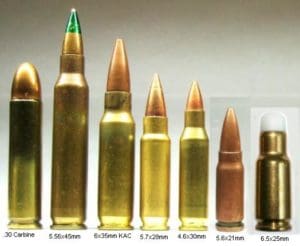
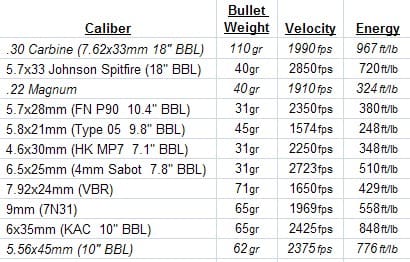
On the whole, I have no doubt that these cartridges offer better armor-piercing capability than any traditional pistol or submachinegun. And that might be enough of a reason to replace the submachinegun for military use, since hollowpoint ammunition is not used for regular military operations.
I’m not sure these PDWs are the best option for law-enforcement use and for hostage-rescue military options. They might very well be, but the stopping power vs. penetration argument is one that has not yet been settled. Many police departments struggle over the issue of 9mm submachinegun/AR15 carbine use in SWAT raids. On the one hand, armor-piercing bullets tend to overpenetrate in unarmored targets. But lighter bullets are less likely to penetrate barriers. Hollowpoints transfer more energy to targets and penetrate less.
Hopefully some reputable agency will conduct thorough testing of barrier penetration and performance on armored/unarmored targets.
[Help us keep our man’s cross-dressing, I mean cross-posting goodness coming. Simply visit www.yankeegunnuts.com. Done.]




You YankeeGunNuts come up with the best stuff! Kudos guys.
You forgot about the grandaddies of PDW pairs (that predate the term): The Thompson submachine gun and the 1911, both chambered in .45 ACP. Heh.
Actually, pistols and submachineguns chambered for pistol calibers are not considered PDWs. Both are designed for short-range use. And the Thompson was considered inferior to the M1 carbine in stopping power for close-in work.
The PDW was born of the military’s desire to give support troops a viable short- to medium-range weapon. The proliferation of body armor rendered guns chambered in pistol calibers ineffective, so the PDW concept generally has the goal of armor penetration as a stated design goal. The .45acp cartridge, even with ball ammo, does not do well at penetrating body armor.
I vote for the S&W 600 grain hardcast: Vel. 1300 fps and energy 2252 ft lbs or the 385 grain core lock hollow point (ultimate home defense round) vel. 1600 fps and 2189 ft lbs.
Now these are great PDW check it out http://current.com/shows/vanguard/87302871_machine-gun-shootout.htm
I have to thank you for the efforts you’ve put in writing this website.
I am hoping to see the same high-grade content from you in the future as well.
In truth, your creative writing abilities has motivated me to get my own, personal website now 😉
Buy the best Marlin Rifles USAMARLINERIFFLES.com right here at Our Marlin Firearms Store. Shop from our amazing collection of brand new Marlin firearms for sale and Best fire arms in stock right now are:
marlin model 60 stock
marlin 795
marlin 1895 trapper
marlin 1895 guide gun
marlin model 25
marlin 336 for sale
marlin 1894
marlin xt-22
marlin camp carbine
marlin 1895 gbl
marlin 1895
rugar marlin 1895
marlin xt
marlin 336c
marlin 780
marlin camp carbine
marlin 1895 trapper
https://usamarlineriffles.com/product-category/accessories/
https://usamarlineriffles.com/product-category/accessories/
Comments are closed.